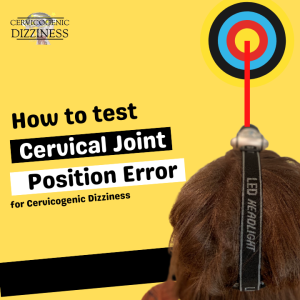Head Steadiness Test
December 2, 2022Neck Flexor Endurance Test
December 20, 2022
How to test cervical joint position error
The cervical joint position error test assesses neck proprioception. It requires the patient to relocate the head to a neutral position after moving it.
In all, an error of more than 4.5 degrees suggests a failure in the precision of head and neck relocalization.
In order to see cervical joint position error, a headlamp with an integrated laser pointer and a target fixed on the wall is needed.
The most common method of assessing cervical joint position error is through the active method.
Test Metrics
In a 2014 study, Cervicogenic Dizziness were more likely than BPPV patients to have an elevated joint position error of 4.5 degrees during the cervical joint position error test.
The test has a sensitivity of 72% and a specificity of 75% when the mean joint position error is more than 4.5 degrees.
The sensitivity and specificity of the test (positive when the joint position error in one position is above 4.5 degrees) are 92% and 54%, respectively.
Use of Passive Rotation in Cervical Joint Position Error Testing
A modification to the cervical torsion test is to place the patient’s head in extension in relationship to the trunk. We use this modification in the clinical setting but so far, it is not studied in research.
You can watch the video below to learn how to perform the passive cervical joint position error test.
It is best to combine the test with the cervical torsion test to assist in distinguishing between cervical afferents disturbance and vestibular dysfunction.
The clinician can also examine other qualitative factors during the test. This includes jerky movements, overshooting or undershooting the initial position, or reproduction of dizziness. All of these can indicate impaired cervical kinaesthetic sense.
This test seems to be a good method to assess neck proprioception that is affected by sensorimotor dysfunction associated with Cervicogenic Dizziness.
Additionally, you can learn more about how we incorporate the cervical torsion test in our algorithm through our books and educational courses!
